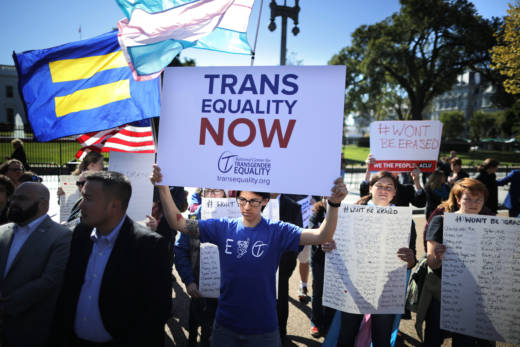Lately we've been noting the reality-bending statements made by President Trump and those in his administration on matters of the environment. Fire, water, earth, air — you might say that for science journalists, fact-checking this presidency is now elemental.
Now comes a New York Times report that the administration is wading into a new area: the complex interplay between biology and gender. On Sunday the paper said that the Dept. of Health and Human Services wants to establish a definition of a person's gender, one that is determined “on a biological basis that is clear, grounded in science, objective and administrable,” as the paper quoted an HHS memo.
“Sex means a person’s status as male or female based on immutable biological traits identifiable by or before birth,” the memo said. “The sex listed on a person’s birth certificate, as originally issued, shall constitute definitive proof of a person’s sex unless rebutted by reliable genetic evidence.”
In other words, your genitals at birth determine your gender. End of discussion.
The move aims to reverse civil rights protections granted to transgender people under the Obama administration, the Times said.
But it would also appear to create an official position by the United States government that transgender people simply don't, well, exist.
And that is going to be news to the roughly 1.4 million transgender individuals in the country.
The American Psychological Association wasted no time in issuing a response to the report. On Monday, it said in a statement:
“For decades, researchers have recognized that gender is not necessarily determined by a person’s biological sex assigned at birth, which can be physiologically uncertain in some cases. Purposely ignoring this body of evidence is indefensible and certain to add to the stress and discrimination already experienced by transgender people.”
Dr. Stephen Rosenthal, a pediatric endocrinologist and the medical director of UCSF's Child and Adolescent Gender Center, agrees.
"A typical transgender person has genitalia that are not in any way obviously abnormal," he said. "And not in any way a clue that that person is going to end up transgender."
Genitalia, he said, does not always predict gender identity, and other physical characteristics most likely contribute to people's fundamental sense of whether they are male, female or some variant. Rosenthal cited a number of studies showing certain parts of the brain, shaped differently in men and women, that are more closely aligned with the gender identity of transgender individuals than with their natal sex.
Other research suggests that genetic and endocrinological differences in transgender people play a role in forming a gender identity that is different than their external sexual characteristics might indicate.
The HHS memo's proposition that genetic testing would clear up any dispute around a person's gender is also wrongheaded, said Rosenthal.
"Anyone, even high school students, know that there are plenty of examples of women with female bodies, female genitalia, let's say, and an unequivocal female gender identity, who happen to have XY chromosomes," he said, referring to the chromosomal pair typically found in males.
The HHS memo would also seem to ignore intersex people — those individuals born with a mix of physical characteristics typically found in only males or females. A 2000 review of the scientific literature by Brown University researchers looked at these deviations from the norm in people born from 1955 on. The survey took into account chromosomes, gonadal structure, hormone levels, internal genital structure and external genitalia, finding that as many as 2 percent of newborns contain some biological trait normally associated with the opposite sex.
One of the researchers, the biologist Ann Fausto Sterling, put it this way in a seminal 1993 essay:
"If the state and the legal system have an interest in maintaining a two-party sexual system, they are in defiance of nature. For biologically speaking, there are many gradations running from female to male; and depending on how one calls the shots, one can argue that along that spectrum lie at least five sexes — and perhaps even more."
Last year, Scientific American took note of the mounting evidence of a male-female biological spectrum. "To varying extents, many of us are biological hybrids on a male-female continuum," wrote the editors. "As science looks more closely ... it becomes increasingly clear that a pair of chromosomes do not always suffice to distinguish girl/boy — either from the standpoint of sex (biological traits) or of gender (social identity)."
Gender Identity: Biopsychosocial
California, of course, has moved beyond tying individuals' biological sexual characteristics to their gender identity. Last year, the state made it easier to officially change genders and added a new category called "nonbinary" to the "male" and "female" options.
Researchers often describe the roots of gender identity as a complex mix of factors that are "biopsychosocial." Surveys in recent years have revealed younger generations as accepting of more customizable views of gender, with some individuals even eschewing the pronouns "he" and "she" in favor of "they" to indicate the duality or fluidity of their identity.
Charlotte Tate, a gender researcher at San Francisco State University, said it's time to move on from debates like the one the Trump administration is trying to foster.
"Historically, science about gender has contained lots of errors that needed to be corrected or discarded," she wrote in an email. "Pretending that gender identity can be reduced to a person’s genitals is one of those errors that we needed to discard in order to move forward in a way that is scientifically productive."
